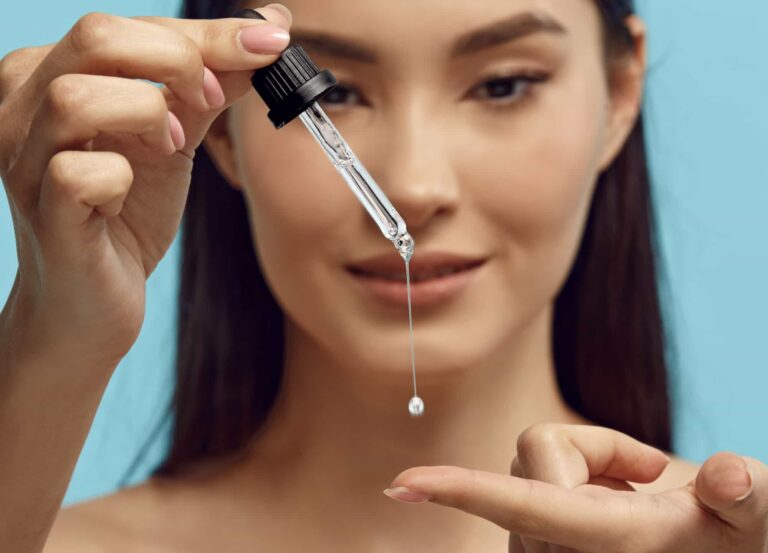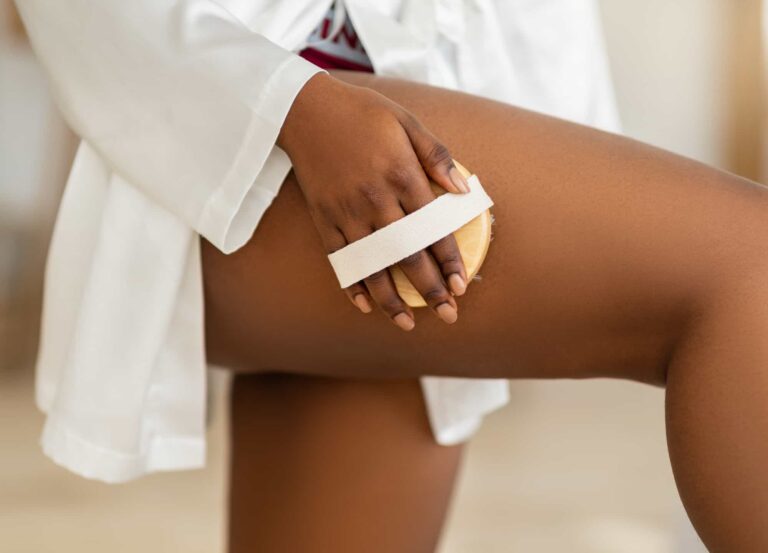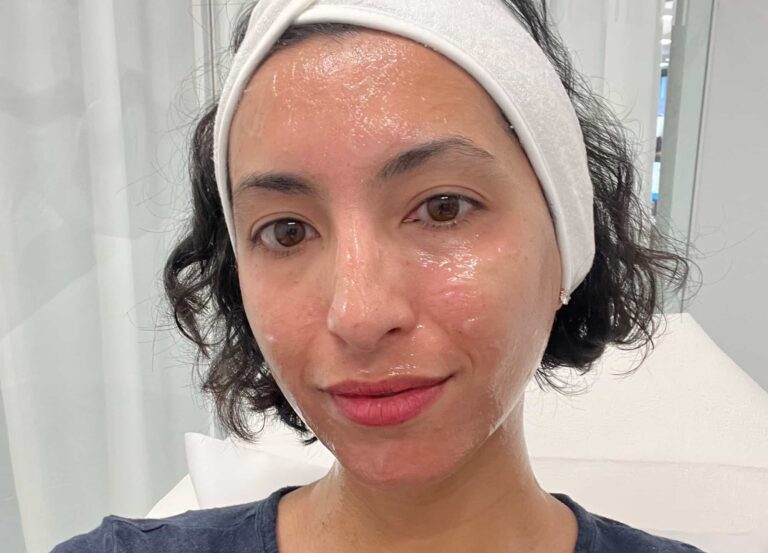These days, we’re bombarded with beauty claims from every direction: social media, television, product labels, our friends and family. But some of these so-called facts just don’t add up. In our new series, Science or Suspect, we set the record straight on what’s true and backed by science—and what claims are just plain suspicious.
When it comes to skin health, we’ve been taught to fear the light: to stay out of the sun’s harmful UV rays so we won’t get skin cancer and, more recently, to be wary of risks associated with the light emitted by our tech devices. But on the flip side, there’s also been a lot of discussion surrounding the therapeutic potential of light—specifically, infrared. Infrared light therapy has been heralded as a sort of cure-all for our humanly ills, treating everything from muscle pain to Alzheimer’s disease to acne. But is there any truth to it in regards to skin?
There has certainly been a lot of attention focused on infrared light therapy in the beauty and wellness industries. Aestheticians and dermatologists incorporate it in their facials, while various skin-care brands have developed their own infrared/LED combo devices, for at-home use. “When infrared light is used in the form of a device, it is thought to help [boost] collagen production, reduce inflammation, and improve skin cell repair,” explains Dr. Marisa Garshick, a board-certified dermatologist in New York City. Meanwhile, infrared sauna treatments are the focus of specialty spas like HigherDose, promising such ambiguous benefits as “skin purification.”
So what exactly is infrared light?
All types of light are measured on the electromagnetic spectrum, with visible light landing between ultraviolet and infrared. In visible light, blue light has one of the shortest wavelengths (between 380 nm and 500 nm); red light falls between the 400–700 nm wavelength range. Red light (which is commonly used in conjunction with infrared light during those aforementioned skin treatments and devices) sits right next to infrared on the electromagnetic spectrum. While we cannot see infrared light with the naked eye, our bodies can feel it as heat. “Infrared light, or infrared radiation, can be produced by the sun, hair dryers, ovens, and light. In fact, infrared accounts for more than 50% of the solar energy that reaches Earth’s surface,” Dr. Garshick says.
Related: 3 Extreme Anti-Aging Treatments That Don’t Actually Work—According to Science and Doctors
The three types of infrared light
There are actually three types of infrared radiation: near-infrared, which has the shortest electromagnetic wavelengths (between 760 nm and1400 nm); mid-infrared, which measures between 1,400 nm and 3,000 nm; and far-infrared, which is between 3,000 nm and 1 mm. Due to its longer wavelength, far-infrared radiation can penetrate the body deeper than near- or mid-infrared radiation—up to 1.5 inches. But advocates of infrared light therapy believe that all three regions encompass different benefits. Kyle Jones, cofounder of iCRYO—a recovery and wellness center offering infrared sauna services—says that all three can improve the skin. He also points to a study that NASA did on near-infrared and red light therapy that showed both to be effective in improving wound healing, due to their ability to reduce inflammation and increase collagen production.
For dermatologists and other skin experts, the focus seems to be mostly on near-infrared. “Low-level light [laser] therapy refers to exposing the skin to low levels of red and near-infrared light, which helps stimulate tissue repair and healing,” Dr. Garshick explains. She says this can also have a beneficial effect on fine lines, wrinkles, acne, and acne scars.
Near-infrared can also be paired alongside other types of LED spectrum light. Dr. Shari Sperling, a board-certified dermatologist in Florham Park, New Jersey, says it can work in tandem with blue light, which is used to treat acne and decrease bacteria on the skin; white light to tighten skin and reduce inflammation; and red light to boost collagen and elastin.
Dr. Ronald Moy, a board-certified dermatologist in Beverly Hills, California, also believes that infrared light therapy combined with LED chromotherapy can improve the skin. “Infrared light therapy penetrates into the skin, to stimulate cell production,” he says. As to whether there are benefits to using infrared on its own, Dr. Moy doesn’t believe there are. “We have not seen infrared light used on its own for skin, because the scientific evidence is scant and based mostly on laboratory experiments using cell cultures,” he says.
However, Dr. Garshick believes infrared can be beneficial when used alone. “Infrared, which can be felt as heat but is considered invisible, can still be used on its own, though many devices combine near-infrared with LED,” she says. “Infrared is next to red light on the electromagnetic spectrum, but because it is a longer wavelength, it can penetrate deeper—so it can be helpful for healing and skin regeneration, even on its own.” While the dermatologists we talked to seem to be all for near-infrared (and red light), none of them mentioned any potential benefits associated with the other two types: mid- and far-infrared light.
There doesn’t seem to be much research centered on the effects of mid-infrared on the skin, but there have been several studies supporting far-infrared. One study showed that far-infrared promoted wound healing in rats. In another study, researchers treated 20 patients who had mild to moderate facial wrinkles and hyperpigmentation with far infrared radiation (at 900–1000 µm) and found that it had improved their skin after six months. “All patients reported good (51–75%) improvements in skin texture and roughness,” the study noted. However, there were no improvements in their hyperpigmented lesions. “These results suggest that infrared radiation may have beneficial effects on skin texture and wrinkles by increasing collagen and elastin,” it concluded.
Related: 6 Dermatologists Over 40 Share Their Holy Grail Skin-Care Product
Are there any risks associated with exposure to infrared light?
With all these potential benefits, there are, of course, a few concerns to keep in mind. For example, a recent study done at Newcastle University in England concluded that UV rays are not the only type of light that can penetrate deep into the skin and create damage—visible and infrared light can also cause harm to our skin cells. “The study reveals that the deeper dermal layer of the skin is damaged by UV, visible, and infrared light,” Dr. Moy says. The combination of UV rays with infrared and visible light generated more cellular damage than from UV rays alone, meaning an increase in premature aging for those exposed to all three wavelengths at the same time.
Another possible risk has to do with melasma and hyperpigmentation. Dr. Garshick believes patients with these conditions should avoid infrared light treatments. “Although it is known that UV light can worsen melasma and hyperpigmentation, infrared heat is also thought to make melasma and hyperpigmentation worse, by stimulating pigment cell production. “Because of this, various skin-care products are being designed to try to help protect the skin against damage from infrared heat—often in the form of antioxidants—to help fight free-radical damage,” says Dr. Garshick. She points out that Obagi Medical Sun Shield Tint Broad Spectrum can help protect against UV and infrared rays as well as heat-related injury and says Skinmedica Total Defense and Repair SPF 50 is a great option to protect skin against UVA, UVB, and infrared. “Topical antioxidants, such as Skinceuticals CE Ferulic, can be helpful, to neutralize free radicals that can be induced by infrared radiation as well as UV radiation,” she adds. Even though it’s become a popular skin-care treatment, it seems that a lot more research on infrared light therapy is needed.











